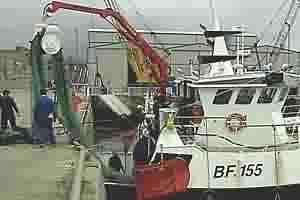|
Conservation measures for North Sea shrimp fisheries that ought to have been brought in by the start of this month are now the subject of an urgent consultation by fisheries departments.
According to the Scottish Executive Environment and Rural Affairs Department, the programme has been allowed to lag in the UK because of the pressure of implementing cod and hake recovery measures.
As a result, legislation for the mandatory use of either a separator trawl or a trawl with a sorting grid in fisheries for common shrimp (Crangon spp) or Aesop shrimp (Pandalus Montagui) will be "brought in as soon as possible".
The Executive has issued a consultation paper with responses to be made by 6 September. The proposals are based on research, mainly into the use of grids and veil nets in the North Sea brown shrimp fishery in which as many as one billion fish are estimated to be discarded annually.
As the fishery takes place on mixed species areas with 22mm mesh nets, the quantity of discards is "significant". An estimated 928 million of the discarded fish are plaice, but other species are also caught.
Most of the fishing (and discards) is undertaken by German and Dutch vessels, although some 10 million fish discards are attributed to UK vessels.
Although the UK-wide consultation is based on recommendations for England, separate Scottish legislation will be drawn up along similar lines.
The draft legislation allows the use of veil or sieve nets and separator grids. Sieve nets consist of a funnel or sheet of netting capable of separating whitefish from shrimp.
Shrimp can pass through the sieve or veil net into a small-mesh cod end while whitefish are directed to an escape hole. The mesh of the veil or sieve net must be at least twice the mesh of the cod end.
As well as the benefits to conservation, veil nets have been adopted because they lead to a cleaner catch with fewer non-target species, such as small fish and crabs.
A variety of mesh sizes are used for veil nets up to 70mm, which is generally considered to be the maximum size at which the veil net is effective in reducing the catch of juvenile fish trapped in the net. Comments are invited on the mesh size of the veil or sieve net.
Sorting grids work on similar principles to a veil net with shrimp passing through a grid to reach the codend while bigger species are directed towards an escape hole. However, the rigid nature of a grid makes it more difficult to operate in practice than a veil or sieve net.
The Executive acknowledges that grids are not widely used by the Scottish industry and that they are unlikely to be widely adopted as a result of the proposals. However, there may be some circumstances where they are more suitable than veil nets. The draft legislation proposes that the bars on a sorting grid should be no more than 20 mm apart. Comments are invited on the requirements for sorting grids.
Sieve nets are already widely used by Scottish fishermen although they are prone to blocking with weed. Vessels generally move on to other areas when there is a lot of loose weed on the grounds.
|
